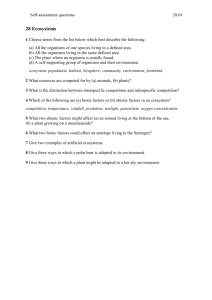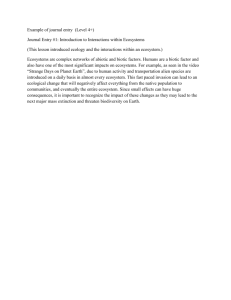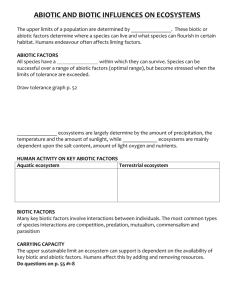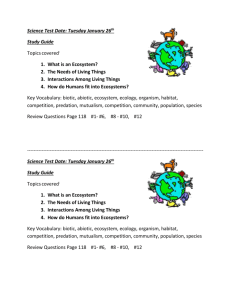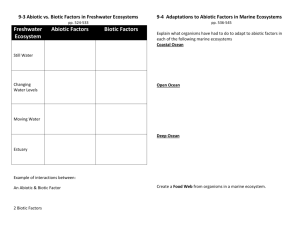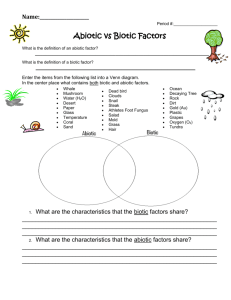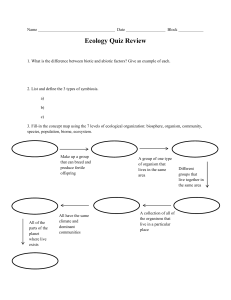Question and Answer
advertisement
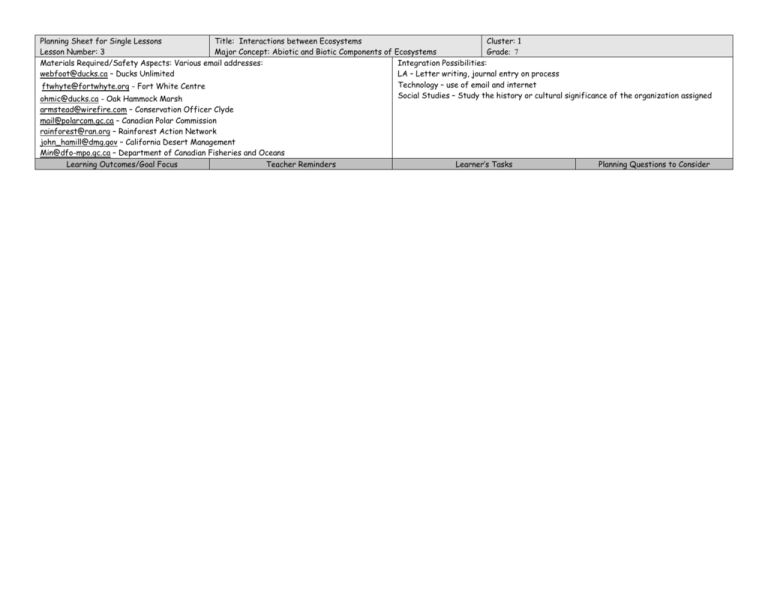
Planning Sheet for Single Lessons Title: Interactions between Ecosystems Cluster: 1 Lesson Number: 3 Major Concept: Abiotic and Biotic Components of Ecosystems Grade: 7 Materials Required/Safety Aspects: Various email addresses: Integration Possibilities: webfoot@ducks.ca – Ducks Unlimited LA – Letter writing, journal entry on process Technology – use of email and internet ftwhyte@fortwhyte.org - Fort White Centre Social Studies – Study the history or cultural significance of the organization assigned ohmic@ducks.ca - Oak Hammock Marsh armstead@wirefire.com – Conservation Officer Clyde mail@polarcom.gc.ca – Canadian Polar Commission rainforest@ran.org – Rainforest Action Network john_hamill@dmg.gov – California Desert Management Min@dfo-mpo.gc.ca – Department of Canadian Fisheries and Oceans Learning Outcomes/Goal Focus Teacher Reminders Learner’s Tasks Planning Questions to Consider Cluster 0 Focus Inquiry/ Design Specific Skills/Attitudes & SLOS Initiating, Researching, Planning Formulate specific questions that lead to investigation. Select and justify a method to be used in finding the answer to a specific question. Implementing & Gathering Info Access information using a variety of sources. Conceptual Understandings Thematic SLOs 7-1-02 – Define ecosystem, and describe various examples that range from the microscopic to the entire biosphere. 7-1-03 – Identify abiotic and biotic components of ecosystems that allow particular organisms to survive. Knowledge/Concept Summary Students will learn about different organizations and how they contribute to a particular ecosystem. They will also learn more about abiotic and biotic interactions within ecosystems. Assessment: What will you assess? I will assess the students’ ability to ask appropriate questions about abiotic, biotic, and ecosystem interactions. How will you assess it? I will assess the students’ understandings through the questions they ask. Will it be diagnostic, formative or summative? Will it be formal or informal? The teacher will put the students into groups. Each group will be assigned an organization which deals with conserving or studying ecosystems (all of which will be contacted before lesson). As a group they will develop questions pertaining to abiotic and biotic interactions within a particular ecosystem. They can also develop questions that directly deal with their particular organization. After the groups finish their question creation, we will have a class discussion on the selection of questions, and to why those questions are valid. We will then discuss what we are trying to accomplish through these questions (i.e. what are the different abiotic and biotic materials in your ecosystem of study; what are the interactions between these materials; how does your organization study or protect an ecosystem?) After our discussion, we will move to the computer lab. The groups will open the email sending programs. They will quickly revise their questions, making sure that they are appropriate for what we are trying to accomplish (as discussed in our class discussion). They will send their questions to their organization. After the class, the teacher will ask the group member who sent the email to check his inbox daily to see if they received a response. The students will be given an email address to an organization that protects or studies a particular ecosystem. They will compile a list questions they want answered about that ecosystem or organization. They will create questions that stress the interaction between abiotic and biotic materials. After the students compile a list of questions, the students will participate in a class discussion on what sorts of questions their group is asking. They will then contribute to a discussion on what they think we are trying to accomplish through our question asking. After our discussion, the students will head to the computer lab. They will go over their questions within their groups. As a group they will revise their questions so that they are appropriate to what we are trying to find out. They will then send their questions as a group. Once students receive a response they will report it to the class. 1. How long will each phase last? -The question creation will be about fifteen minutes. -The discussion will be about ten minutes. -The computer lab will be ten - fifteen minutes. 2. How will I organize groups? - Groups will be organized in the same fashion as lesson 1. 3. How will I organize, distribute & collect equipment? -Materials will be handed out at the beginning of class before the students’ arrival. 4. What questions might I ask to extend learning or further student understandings? - How do the different types of ecosystems affect the interaction of abiotic and biotic elements? -How do these organizations protect the interaction between abiotic and biotic elements in ecosystems? 5. How am I connecting this lesson to prior ones? - This lesson is linked to previous lessons because it is about generating questions and acquiring knowledge about the concepts that we have already activated in the first two previous lessons. It reinforces the students understanding about abiotic and biotic elements in an ecosystem through answers from professionals in the field. 6. What must I look for to monitor student learning? - I am looking for exemplary question making in the groups that shows an understanding in the basic concepts of abiotic and biotic interactions within an ecosystem.
